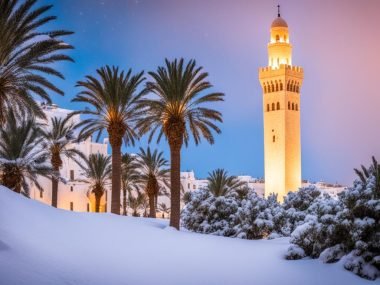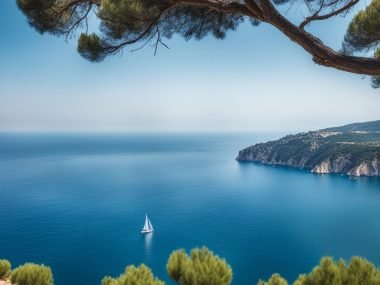Did you know Tunisia is Africa’s most northern country? It’s nestled between Algeria and Libya. Its stunning scenery includes the Atlas Mountains and the Mediterranean sea. Tunisia is a mix of old cultures and modern Arab-Berber life.
Tunisia is known as the Republic of Tunisia. It lies at coordinates 34°N 9°E. The capital, Tunis, is at 36°49′N 10°11′E. Tunis is full of history and modern excitement.
Key Takeaways
- Tunisia is the northernmost country in Africa.
- Located between Algeria and Libya in North Africa.
- Officially known as the Republic of Tunisia.
- Geographical coordinates are 34°N 9°E for the country, and 36°49′N 10°11′E for the capital, Tunis.
- Rich in ancient civilisations and diverse cultural heritage.
Overview of Tunisia
Tunisia is known as the Republic of Tunisia and is in North Africa. Its motto is “Freedom, Order, Justice” and it sings “Humat al-Hima” with pride. The country has President Kais Saied and Prime Minister Ahmed Hachani leading it.
Republic of Tunisia
The Republic of Tunisia is really big, about 163,610 km². Around 11,708,370 people live there as of 2020. Most people are Arabs and French is widely spoken too.
Location in North Africa
Tunisia is right in the heart of North Africa. It’s very important in the Maghreb region. The country links the western and eastern Mediterranean. So, it’s key for connection and influence. The Tunisia map shows how it joins North Africa and more.
| Aspect | Details |
|---|---|
| Official Name | Republic of Tunisia |
| Location | North Africa |
| Area | 163,610 km² |
| Population (2020) | 11,708,370 |
| Languages | Arabic (official), Tunisian Arabic, French |
Tunisia’s geography is very diverse. It has coasts, mountains, and even part of the Sahara. This mix shapes its unique culture and nature.
Tunisia’s Geographical Coordinates
Tunisia sits at 34 degrees North and 9 degrees East. This means it is in the temperate zone in the northern hemisphere of Africa. This position is key to understanding its geography, especially in the Maghreb region.
Tunisia has a Mediterranean climate. This influences its varied landscape and weather. Its location affects ecosystems, trade, and tourism. It is unique in the Maghreb for its diverse areas – mountains up north, farming lands in the centre, and deserts down south.
| Geographical Aspect | Description |
|---|---|
| Latitude | 34 degrees North |
| Longitude | 9 degrees East |
| Climate | Mediterranean |
| Region | Maghreb |
| Key Features | Mountains, Arable Land, Deserts |
The Capital of Tunisia: Tunis
Tunis is the capital of Tunisia and is full of life and history. It is in North Africa. The city is at 36°49′N 10°11′E.
Coordinates of Tunis
Tunis is very important geographically. It is the biggest city in Tunisia. It is the centre of politics, economy, and culture.
It lays near the Gulf of Tunis, behind Lake Tunis and La Goulette port. Its location is key for trade and governance in Tunisia’s history.
Historical Significance
The story of Carthage is part of Tunis. The city’s old part is a UNESCO site.
In the east, there are landmarks like Carthage, La Marsa, and Sidi Bou Said. They show Tunis’s rich history. The city has seen Phoenicians, Romans, and Arab Muslims.
Neighbours and Borders of Tunisia
Tunisia is in North Africa, in a region called the Maghreb. It shares big borders with Algeria and Libya. These borders shape its land and how it talks and deals with others in the area.

Borders with Algeria
The western and southwestern edges of Tunisia meet Algeria. They share a border that’s about 965 kilometres long. This border helps Tunisia and Algeria trade and share culture. It makes the bond between them strong and shows how Tunisia’s land is set up.
Borders with Libya
To the southeast, Tunisia and Libya share a 459-kilometre border. This line is key for trading and meeting each other. They share history and economic ties. This shows how countries in the Maghreb region are connected. It highlights Tunisia’s big role in the area.
| Border | Length (km) | Significance |
|---|---|---|
| Algeria Border | 965 | Economic and Cultural Exchange |
| Libya Border | 459 | Trade and Historical Narratives |
The Algeria and Libya borders show how important Tunisia is in the Maghreb. They influence its politics and economy. Tunisia’s spot on the map is key to understanding North Africa.
Overview of the Tunisian Region
Tunisia sits where the Mediterranean’s charm meets the Sahara’s vastness. It’s in North Africa, linking the Middle East and Africa together. This area has mountains, plains, and the vast Sahara Desert.
Its map points to a rich history of empires and cultures, thanks to its strategic location. Today, it draws millions with its history, vibrant life, warm climate, and beauty.
It has the Atlas Mountains and the Sahara Desert. This mix highlights Tunisia’s historical and cultural worth. Truly, this nation is the heart of North Africa, blessed with rich culture and stunning nature.
Tunisia’s Location Near the Mediterranean Sea
Tunisia is next to the beautiful blue Mediterranean Sea. Both its north and east sides touch the sea. This spot is important for the country’s maritime borders. It has a long coastline of 1,300 km. Being in this place has helped Tunisia trade with other countries.
Maritime Borders
Tunisia’s sea border touches several countries, like Italy. It is close to islands such as Sicily and Sardinia. These maritime borders help with things like fishing and bringing in tourists. This makes Tunisia an important sea country.
Trade and Commerce
Being near the Mediterranean Sea has always helped Tunisia trade. It has been part of big trade routes. This trade is key for the country’s money. It also makes Tunisia an important part of world trade.
Also, Tunisia’s trade is about different things. They export farm products, clothes, and other goods. They have big ports for sending goods easily. This shows how important the sea is for Tunisia’s trade.
| Aspect | Details |
|---|---|
| Maritime Length | 1,300 km |
| Bordering Countries | Italy, Malta, and others |
| Key Economic Activities | Fishing, Tourism, Trade |
Topographical Highlights of Tunisia
Tunisia boasts a diverse topography due to its unique features.
Atlas Mountains
The Atlas Mountains are key to Tunisia’s geography. They stretch across the northwest. This range affects the climate and supports farming. It also helps in keeping biodiversity and managing water. Their tall peaks and green valleys are different from Tunisia’s south.
Sahara Desert
The Sahara Desert is in Tunisia’s south, unlike the green Atlas Mountains. It is a huge desert that is a big part of Tunisia’s topography. Endless dunes and special ecosystems mark this place. It draws adventurers and is home to many cultures living in the dry land. This contrast shows Tunisia’s geography is very varied.
The Atlas Mountains and the Sahara Desert highlight Tunisia’s topography diversity.
Climate and Weather in Tunisia
The Tunisia climate changes from the north to the south. The north has a nice Mediterranean climate. Here, winters are soft with a lot of rain. This makes the land very green in the cold months. Summers are hot and dry, perfect for the beach.
As you go south, it gets drier, until you hit the Sahara desert. The Tunisia weather in these places can be very hot in the day but cold at night. The hot sirocco winds can make it really dry and hot sometimes.
The different Tunisia climate is important for daily life. In the north, farmers grow olives because of the rain in winter and dry summers. But in the south, it’s too dry for many plants. Yet, some plants that don’t need much water do well here.
The Tunisia weather and Mediterranean climate make the country special. This affects the plants, animals, and how people live.
Tunisia on the Map
Tunisia is very important on the map of Africa. It’s mostly in North Africa and is a big deal in the Maghreb region. Its place shows how key it is to both Africa and the wider Maghreb area.
Continent: Africa
Tunisia is in the north of Africa continent. This special spot shows how important its geography is. It also brings out the many cultures, languages, and landscapes of Africa. Being where it is on the map, Tunisia plays a big role in Africa’s past and today.
Region: Maghreb
Tunisia is a central part of the Maghreb region in North Africa. The Maghreb is known for its shared culture and history. Tunisia is a major piece there. Its map not only shows its borders. It also shows its connections within the Maghreb. This helps it keep up trade, cultural exchanges, and diplomatic ties.
Understanding Tunisia’s Coordinates
Tunisia’s exact spot is shown by its coordinates. These are latitude and longitude numbers. They’re key for geography and much more.
They help in ways like navigating, studying weather, and setting clocks.
Importance of Latitude and Longitude
These numbers help find Tunisia on a map. Coordinates like 34°N 9°E help with many tasks. They’re key not just for maps.
They also help in science work, studying weather, and keeping time.
Map Reading Techniques
Knowing how to read maps is vital for understanding Tunisia. You need to know about scales, symbols, and lines of latitude and longitude. This knowledge helps explore Tunisia’s lands and recognize its spot near the sea and desert.
So, reading maps well lets us appreciate Tunisia’s important global position.
Cultural and Historical Significance of Tunisia
Tunisia is a country full of rich culture and deep history. It mixes Berber, Arab, and Mediterranean roots. You can see this mix in its traditions, food, buildings, and daily life.
Cultural Diversity
Tunisia’s culture comes from many places, showing its varied heritage. Berber, Arab, and Mediterranean influences blend together here. You see this in its colourful markets, different languages, and food.
Historical Landmarks
Tunisia’s history can be seen in its cultural landmarks across the country. Ancient Carthage tells the story of a once mighty power. The Great Mosque of Kairouan is important for Tunisia’s Islamic past. And the amphitheatre of El Jem shows Roman influence.
These landmarks are key for learning Tunisia’s history. They show how the country grew from ancient times to now. It’s like seeing history layer by layer.
Where Did Tunisia Located?
The Tunisia location is at the very top of Africa. It looks over the Maghreb region. Tunisia has many different landscapes, from beaches to the Sahara Desert.

Geographical Overview
Tunisia is a crossroads in the Maghreb region. It has green plains, big mountains, and dry deserts. Its spot by the sea helps with trade and business.
Historical Context
History in Tunisia is filled with stories of old civilisations. The city of Carthage was set up by the Phoenicians. This shows how important Tunisia was.
Rome ruled Tunisia once. Its location helped in sea trade and military moves. This was within the Mediterranean.
Tunisia’s past and place make it special in Africa and the Maghreb region. To fully get Tunisia, we must look at its geography and history.
Conclusion
Tunisia is very important in North Africa because of where it is and its culture. It sits where the Mediterranean Sea meets the Sahara Desert. This spot has helped shape Tunisia’s history and how it grows today. You can see the Maghreb influence in its beautiful coastal areas and large deserts.
This country has a long history full of stories from old times and today. You can find ancient ruins and also see busy cities like Tunis. These places show a mix of old and new things. This mixture helps make Tunisia special today, not just in the past.
Tunisia is known for its deep history and different cultures. Its unique spot has helped it in the past and will help it in the future. Tunisia connects Africa, the Arab world, and Europe. This makes Tunisia very important in the world.







